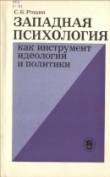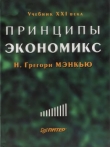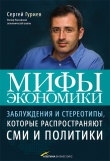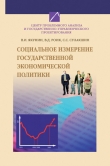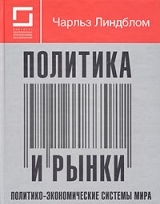
Текст книги "Политика и рынки. Политико-экономические системы мира"
Автор книги: Чарльз Линдблом
сообщить о нарушении
Текущая страница: 35 (всего у книги 38 страниц)
39
Riskin. «Workers’ Incentives».
40
Joseph A. Kahl. «Cuban Paradox» in «Cuban Communism», ed. Irving L. Horowitz (New Brunswick, N.J.: Transaction, 1972), p. 288.
41
Bruce M. Russett et al. «World Handbook of Political and Social Indicators» (New Haven, Conn.: Yale University Press, 1964), p. 243. Оценку, подтверждающую эти данные, см. в: Р. J. D. Wiles. «The Political Economy of Communism» (Cambridge, Mass.: Harvard University Press, 1964), p. 48.
42
W. Irwin Gillespie. «Effect of Public Expenditures on the Distribution of Income» in «Essays in Fiscal Federalism», ed. Richard A. Musgrave (Washington, D.C.: Brookings Institution, 1965), pp. 164-165.
43
Более подробно о неэгалитарных государственных расходах см. в: William С. Mitchell. «Public Choice in America» (Chicago: Markham, 1971), chapter 4.
44
Morton Paglin. «The Measurement and Trend of Inequality» // «American Economic Review» 65 (September 1975). Тем не менее необходимо помнить, что данные очень неточны. Ричард Титмакс видит признаки постепенного отхода от идей равенства, по крайней мере в Великобритании: Richard Titmucs. «Income Distribution and Social Change» (London: George Allen & Unwin, 1962), p. 198.
45
James E. Meade. «Efficiency, Equality, and Ownership of Property» (Cambridge, Mass.: Harvard University Press, 1965), pp. 38-39.
46
«The Private Lives of Russia’s Rulers», Atlas (July-August 1971): 20-27; Andrei D. Sakharov. «My Country and the World» (New York: Alfred A. Knopf, 1975), pp. 25-27; а также о Китае и СССР см. в: Jacqueline R. Kasun. «United States Poverty in World Perspective» // «Current History» 64 (June 1973): 251-252.
47
Matthews. «Revolution in Cuba», pp. 380-381; Archibald R. M. Ritter. «The Economic Development of Revolutionary Cuba: Strategy and Performance» (New York: Praeger, 1974), p. 288ff.
48
Arthur G. Ashbrook, Jr. «China: Economic Overview, 1975», Joint Economic Committee, China, p. 51.
49
David P. Barkin and Nita R. Manitzas, eds. «Cuba: The Logic of the Revolution» (Andover, Mass.: Warner Modular Publications, 1973), pp. M261-269.
1
Franz Schurmann. «Ideology and Organization in Communist China», 2nd ed., enl. (Berkeley: University of California Press, 1971), p. 46. См. также: James Chieh Hsiung. «Ideology and Practice» (New York: Praeger, 1970), p. 155. Сравнение с СССР см. в: Merle Fainsod. «Transformations in the Communist Party of the Soviet Union» in «Soviet and Chinese Communism», ed. Donald W. Treadgold (Seattle: University of Washington Press, 1967).
2
О «культурной революции» см.: Schurmann. «Ideology and Organization»; Jörgen Domes. «Party Politics and the Cultural Revolution» in «Communist China, 1949-1969», eds. Frank N. Trager and William Henderson (New York: New York University Press, 1970); A. Doak Barnett. «Uncertain Passage» (Washington, D.C.: The Brookings Institution, 1974), pp. 6-8.
3
James R. Townsend. «Political Participation in Communist China», 2nd ed. (Berkeley: University of California Press, 1969), pp. 39, 45, 83.
4
Schurmann. «Ideology and Organization», p. 32.
5
Derek J. Waller. «Revolutionary Intellectuals or Managerial Modernizes» // «Political Quarterly» 45 (January-March 1974): 12.
6
Barry М. Richman. «Industrial Society in Communist China» (New York: Random House, 1969), pp. 258, 766.
7
Harvey Leibenstein. «Allocative Efficiency vs. ‘X-Efficiency’» // «American Economic Review» 56 (June 1966).
8
Hsiung. «Ideology and Practice», p. 297.
9
Ibid., p. 282.
10
Barnett. «Uncertain Passage», pp. 139-141.
11
Ezra F. Vogel. «Voluntarism and Social Control» in «Soviet and Chinese Communism», ed. Treadgold, p. 178.
12
Из Дэн Сяопина, цит. по: J. М. Н. Lindbeck. «Transformations in the Chinese Communist Party» in «Soviet and Chinese Communism», ed. Treadgold, p. 103.
13
Richard H. Solomon. «Mao’s Revolution and the Chinese Political Culture» (Berkeley: University of California Press, 1971), p. 506.
14
Schurmann. «Ideology and Organization», p. 48.
15
Ernesto Guevara. «Man and Socialism in Cuba» in «Che: The Selected Works of Ernesto Guevara», eds. R. E. Bonachea and N. P. Valdes (Cambridge, Mass.: MIT Press, 1970), p. 159.
16
Richard R. Fagen. «The Transformation of Political Culture in Cuba» (Stanford, Calif.: Stanford University Press, 1969), p. 146.
17
James M. Malloy. «Generation of Political Support and Allocation of Costs» in «Revolutionary Change in Cuba», ed. Carmelo Mesa-Lago (Pittsburgh: University of Pittsburgh Press, 1971), p. 41.
18
Carmelo Mesa-Lago. «Cuba in the 1970’s» (Albuquerque: University of New Mexico Press, 1974), chapter 3.
19
В Советском Союзе в сельском хозяйстве занята примерно четверть рабочей силы, и данная отрасль производит около одной пятой валового национального продукта. В Китае в агропромышленном производстве занято, вероятно, около 70 процентов рабочей силы, которые производят приблизительно от одной четвертой до половины валового национального продукта. На Кубе около 30 процентов рабочей силы, занятой в сельском хозяйстве, производит, по приблизительным оценкам, около 25 процентов валового национального продукта. U.S. Congress, Joint Economic Committee, Soviet Economic Prospects for the Seventies, 93rd Congress, 1st session, 1973, p. 341; United Nations, Yearbook of Labour Statistics 1975 (Geneva: International Labour Office, 1975), pp. 71, 89, 157; Charles L. Taylor and Michael C. Hudson. «World Handbook of Political and Social Indicators», 2nd ed. (New Haven, Conn.: Yale University Press, 1972), p. 338; Jan Deleyne. «The Chinese Economy» (New York: Harper & Row, 1974), p. 62; David P. Barkin. «Cuban Agriculture: A Strategy of Economic Development» in «Cuba: The Logic of the Revolution», eds. David P. Barkin and Niki R. Manitzas (Andover, Mass.: Warner Modular Publications, 1973), pp. R261-10 to R261—13. В Соединенных Штатах в сельском хозяйстве занято около 4 процентов рабочей силы, которая производит около 4 процентов ВНП.
20
Jan S. Prybyla. «The Political Economy of Communist China» (Scranton, Pa.: International Textbook, 1967), p. 159.
21
Paul Dibb. «Soviet Agriculture since Khrushchev: An Economic Appraisal» in «Comparative Economic Systems: A Reader», ed. Marsall I. Goldman, 2nd ed. [New York: Random House, 1971], p. 372. J. Wilczynski. «The Economics of Socialism» (London: Allen & Unwin, 1970), p. 120ff, особенно c. 123; Frederick W. Cook. «The Commune System in the People’s Republic of China, 1963-1974», U.S. Congress Joint Committee Print, «China: A Reassessment of the Economy» 94th Congress, 1st session, 1975, p. 399ff; Carmelo Mesa-Lago. «The Revolutionary Offensive» // «Trans-Action» 6 (April 1969): 23.
22
Dwight H. Perkins. «Market Control and Planning in Communist China» (Cambridge, Mass.: Harvard University Press, 1966), pp. 33-93. Из-за применения соответствующей системы стимулов в Китае, возможно, в гораздо меньшей степени, чем в СССР, крестьянам, занятым в индивидуальном производстве или производстве бригадным методом, разрешается заниматься малым предпринимательством и ремеслами – например, изготовлением керамики и изделий из древесины. Политические подходы могут различаться по степени ограничений, устанавливаемых на деятельность подобного рода (Crook. «The Commune System», p. 332).
23
Dibb. «Soviet Agriculture», p. 363; Wilczynski. «The Economics of Socialism», p. 123; Robert Conquest, ed. «Agricultural Workers in the U.S.S.R.» (London: Bodley Head, 1968), p. 114.
24
Prybyla. «Political Economy», pp. 350-351; Barry H. Richman. «Industrial Society in Communist China» (New York: Random House, 1969), p. 544.
25
Conquest. «Agricultural Workers», pp. 8-9.
26
Северная Корея также в настоящее время проводит эксперименты по использованию различных методов морального стимулирования. См. в: Byung Chul Koh. «North Korea: Profile of a Garrison State» // «Problems of Communism» 18 (January-February 1969): 22; Joungwon Alexander Kim. «The ‘Peak of Socialism’ in North Korea: The Five and Seven Year Plans» in «Comparative Economic Systems», ed. Jan S. Prybyla (New York: Appleton-Century-Crofts, 1969), pp. 417,423.
27
Wilczynski. «The Economics of Socialism», pp. 107-108, 164.
28
Emily Clark Brown. «Continuity and Change in the Soviet Labor Market» in «The Soviet Economy», eds. Morris Bernstein and Daniel R. Fusfeld, 4th ed. (Homewood, Ill.: Irwin, 1974); Wilczynski. «The Economics of Socialism», p. 99; E. H. Phelps Brown. «The Economics of Labor» (New Haven, Conn.: Yale University Press, 1962), pp. 122-123; Merle Fainsod. «How Russia Is Ruled», rev. ed. (Cambridge, Mass.: Harvard University Press, 1963), pp. 106-107.
29
Alexander Eckstein. «China’s Economic Development» (Ann Arbor: University of Michigan Press, 1975), pp. 362-364.
30
Carl Riskin. «Workers’ Incentives in Chinese Industry» in Joint Economic Committee, China.
31
Prybyla. «Political Economy», pp. 261-262.
32
Carmelo Mesa-Lago. «The Labor Sector and Socialist Distribution in Cuba» (New York: Praeger, 1968), chapter 3.
33
Mesa-Lago. «Economic Significance of Unpaid Labor in Socialist Cuba» // «Industrial and Labor Relations Review» 22 (April 1969).
34
Mesa-Lago. «Cuba in the 1970’s», p. 48.
35
James M. Malloy. «Generation of Political Support and Allocation of Costs» in «Revolutionary Change in Cuba», ed. Carmelo Mesa-Lago (Pittsburgh: University of Pittsburgh Press, 1971), p. 35.
36
Raul Castro in «New York Times», 8 December 1972, p. C. 11.
37
Mesa-Lago. «Cuba in the 1970’s», p. 70.
38
Frank N. Trager and William Henderson, eds. «Communist China, 1949-1969» (New York: New York University Press, 1970), p. 50; Donald DeGlopper. «Recent Changes in Chinese Society» // «The Annals» 402 (July 1972): 25; Frederick G Barghoorn. «Politics in the U.S.S.R.», 2nd ed. (Boston: Little, Brown, 1972), p. 70; Roberto E. Hernandez and Carmelo Mesa-Lago. «Labor Organization and Wages» in «Revolutionary Change», ed. Mesa-Lago, p. 210ff.
39
Richman. «Industrial Society», pp. 147, 163.
40
Ibid., p. 304.
41
Riskin. «Workers’ Incentives», p. 214ff; Ritter. «Revolutionary Cuba», pp. 327-329.
42
Richard R. Fagen. «The Transformation of Culture in Cuba» (Stanford, Calif.: Stanford University Press, 1969), p. 142.
43
Robert M. Bernardo. «The Theory of Moral Incentives in Cuba» (University, Ala.: University of Alabama Press, 1971), pp. 54-55; Riskin. «Workers’ Incentives», p. 215.
44
В Китае материальные вознаграждения участникам соцсоревнований отменены (Riskin. «Workers’ Incentives,» р. 222).
45
Bernardo. «Moral Incentives», pp. 60-61.
46
Arvid Brodersen. «The Soviet Worker» (New York: Random House, 1966), p. 135.
47
Richard Lowenthal. «Development vs. Utopia in Communist Policy» in «Change in Communist Systems», ed. Chalmers Johnson (Stanford, Calif.: Stanford University Press, 1970).
48
Mesa-Lago. «Cuba in the 1970’s», pp. 44-45.
49
Archibald R. M. Ritter. «The Economic Development of Revolutionary Cuba: Strategy and Performance» [New York: Praeger, 1974], pp. 264-269; Riskin. «Workers’ Incentives»,p. 215.
50
Richman. «Industrial Society», p. 53.
51
Например, см.: Eckstein. «China’s Economic Development», p. 366.
52
Charles Hoffman. «Work Incentives in Chinese Industry and Agriculture» in U.S. Congress, Joint Economic Committee, «An Economic Profile of Mainland China», 90th Congress, 1st session, 1967, vol. 2, pp. 491-492; Brodersen. «The Soviet Worker», pp. 132-138.
53
Bernardo. «Moral Incentives», pp. 67-68.
54
Ibid., p. 120.
55
Malloy. «Political Support», p. 37ff.
56
Ritter. «Revolutionary Cuba», p. 326ff.
57
Ibid., p. 326.
58
Bernardo. «Moral Incentives», pp. 102-114; см. также: Ritter. «Revolutionary Cuba», chapters 7 and 8.
59
Mesa-Lago. «Unpaid Labor», p. 347.
60
Bernardo. «Moral Incentives», pp. 89, 121.
61
Hernandez и Mesa-Lago в «Labor Organization and Wages», p. 238ff выражают больше сомнений, чем Maurice Zeitlin в «Inside Cuba» // «Ramparts» 8 (March 1970).
62
Hoffman. «Work Incentives», p. 494; Richman. «Industrial Society», p. 260ff.
63
Данные по Кубе см. в: Ritter. «Revolutionary Cuba», p. 288ff.
64
Karl Marx. «Early Writings», trans. and ed. T. B. Bottomore (New York: McGraw-Hill, 1964), p. 193.
1
Raymond Р. Powell. «Plan Execution and the Workability of Soviet Planning» // «Journal of Comparative Economics» 1 (March 1977); Barry H. Richman. «Industrial Society in Communist China» (New York: Random House, 1969), p. 462.
2
Archibald R. M. Ritter. «The Economic Development of Revolutionary Cuba: Strategy and Performance» (New York: Praeger, 1974), p. 224.
3
Simon Kuznets. «Modern Economic Growth» (New Haven, Conn.: Yale University Press, 1966), pp. 64-65.
4
Harry G. Shaffer. «Economic Performance under the Plan» in «Current Problems of Socialist Economics», ed. William D. G. Hunter, mimeographed (Hamilton, Canada: McMaster University, 1971), p. 58.
5
World Bank, World Bank Atlas (Washington, D.C., 1975). Сравнительный анализ с другими странами дан в таблице 22.2.
6
Arthur Ashbrook. «China: Economic Overview, 1975», U.S. Congress, Joint Economic Committee, «China: A Reassessment of the Economy», 94th Congress, 1 st session, 1975, p. 44.
7
Claire Wilcox et al. «Economies of the World Today», 3rd ed. (New York: Harcourt Brace Jovanovich, 1976), p. 19. В основном по материалам World Bank Atlas 1975.
8
Данные по 1959-му и 1960 гг.: Ritter. «Revolutionary Cuba», р. 111. О спаде в 1960-х годах и современных требованиях: Carmelo Mesa-Lago. «Cuba in the 1970’s» (Albuquerque: University of New Mexico Press, 1974), 53-54.
9
Stanley H. Cohn. «Analysis of the Soviet Growth Model» in «The Soviet Economy», eds. Morris Bornstein and Daniel Fusfeld, 4th ed. (Homewood, Ill.: Irwin, 1974); Cyril E. Black. «Soviet Society: A Comparative View» in «Prospects for Soviet Society», ed. Allen Kassof (New York: Praeger, 1968), p. 32.
10
J. Wilczynski. «The Economics of Socialism» (Chicago: Aldine, 1970), p. 82. U.S. Congress, Joint Economic Committee, «Current Economic Indicators for the U.S.S.R.», 89th Congress, 1st session, 1965. См. также другие показатели: Abram Bergson. «Soviet Post-War Economic Development» (Stockholm, Sweden: Almqvist & Wiksell International, 1974).
11
Cohn. «Soviet Growth Model», p. 250; Shaffer. «Economic Performance», p. 38. Попытка, хотя и со многими ошибками, измерить производительность факторов производства в СССР, США, Франции, ФРГ и Великобритании, показавшая наилучший результат продуктивности у США и наихудший – у СССР, производилась Бергсоном. См.: Abram Bergson. «Productivity under Two Systems» in «Optimum Social Welfare and Productivity», eds. Jan Tinbergen et al. (New York: New York University Press, 1972).
12
A. H. Brown. «Political Change in Czechoslovakia» // «Government and Opposition» 4 (Spring 1969): 180.
13
Gregory Grossman. «Soviet Growth: Routine, Inertia, and Pressure» // «American Economic Review» 50 (May 1960): 69.
14
Цит. no: Gregory Grossman. «Innovation and Information in the Soviet Economy» // «American Economic Review» 56 (May 1966): 126-127.
15
Joseph Goldmann and Karel Kouba. «Economic Growth in Czechoslovakia» (Prague, 1969), pp. 83-91 ff.
16
Об инновациях в рыночной экономике и авторитарных системах управления см. в: Benjamin N. Ward. «The Socialist Economy» (New York: Random House, 1967), pp. 149-157.
17
См. краткий обзор существующих проблем: Grossman. «Innovation and Information». См. также: Joseph S. Berliner. «The Innovation Decision in Soviet Industry» (Cambridge, Mass.: MIT Press, 1976). Глубокий всесторонний анализ влияния в области политики см. в: Moshe Lewin. «Political Undercurrents in Soviet Economic Debates» (Princeton, N.J.: Princeton University Press, 1974), pp. 153-154. О влиянии в области внутренних реформ и в области отношений между европейскими странами см.: R. V. Burks. «Technology and Political Change in Communist Systems» in «Change in Communist Systems», ed. Chalmers Johnson (Stanford, Calif.: Stanford University Press, 1970).
18
Региональная децентрализация управления советской экономикой, осуществленная Хрущевым в середине 50-х годов, в основном была признана неудачной (Abraham Katz. «The Politics of Economic Reform in the Soviet Union» [New York: Praeger, 1972], chapter 5). При проведении новых реформ децентрализация осуществлялась уже непосредственно на уровне самого предприятия (J. М. Montias. «East European Reforms in Retrospect», U.S. Senate, Committee on the Judiciary, Subcommittee on Antitrust and Monopoly, Hearings on Economic Concentration, 90th Congress, 2nd session, 1968, part 7).
19
Galia Golan. «The Czechoslovak Reform Movement» (London: Cambridge University Press, 1971) and «Reform Rule in Czechoslovakia» (London: Cambridge University Press, 1973); Brown. «Political Change in Czechoslovakia».
20
Более подробный обзор реформ см. в: Gertrude Е. Schroeder. «Soviet Economic Reform at an Impasse» // «Problems of Communism» 20 (July-August 1971).
21
Katz. «Economic Reform», p. 179.
22
Gertrude E. Schroeder. «Recent Developments in Soviet Planning and Incentives» in U.S. Congress, Joint Economic Committee, «Soviet Economic Prospects for the Seventies», 93rd Congress, 1st session, 1973.
23
Цит. no: Michael Ellman. «Soviet Planning Today» (Cambridge: Cambridge University Press, 1971), p. 53, из А. и H. Кобринских. «Много ли человеку нужно?» (1969), с. 173.
24
Jeremy R. Azrael. «Managerial Power and Soviet Politics» (Cambridge, Mass.: Harvard University Press, 1966). Обзор имеющихся разнообразных концепций см. в: Willem Keizer. «The Soviet Quest for Economic Rationality» (Rotterdam: Rotterdam University Press, 1971), p. 291ff.
25
Хорошее обсуждение влияния сложной социальной структуры на ослабление правительственного управления и контроля, по каковому вопросу до сих пор общественные науки преимущественно занимаются производством гипотез, а не сбором эмпирических доказательств, см. в: Chalmers Johnson. «Comparing Communist Nations» in «Change in Communist Systems», pp. 15-26, особенно c. 23-24.
26
Цит. no: Morris Bornstein, ed. «Plan and Market» (New Haven, Conn.: Yale University Press, 1973), p. 383.
27
Цит. no: Moshe Lewin. «Political Undercurrents in Soviet Economic Debates» (Princeton, N.J.: Princeton University Press, 1974), p. 230ff.
28
Michael Ellman. «Planning Problems in the U.S.S.R.» (Cambridge: Cambridge University Press, 1973), p. 141ff.
29
Lewin. «Political Undercurrents», p. 222ff.
30
Ellman. «Planning Problems», p. 140.
31
Cm.: Lewin. «Political Undercurrents», chapter 8.
32
Ibid., pp. 223, 226-227.
33
Peter Wiles. «The Political Economy of Communism» (Cambridge, Mass.: Harvard University Press, 1964), p. 111.
34
Ibid., p. 122. О ценах в Китае см.: Richman. «Industrial Society», pp. 381, 463. О ценах на Кубе см. в: Carmelo Mesa-Lago and Luc Zephirin. «Central Planning» in «Revolutionary Change in Cuba», ed. Carmelo Mesa-Lago (Pittsburgh: University of Pittsburgh Press, 1971), p. 176.
35
Wiles. «Economy of Communism», p. 152.
36
Katz. «Economic Reform», pp. 197-198 и в других местах.
37
Обсуждение влияния экономических реформ на отношения между коммунистическими странами см. в: R. V. Burks. «The Political Implications of Economic Reform» in Bornstein, ed. «Plan and Market».
38
Wilczynski. «Economics of Socialism», p. 127.
39
Как, например, во многих дебатах по предложениям Либермана в СССР (в середине 60-х годов имя Евсея Либермана было связано с предложениями о применении процедур рыночной экономики в советской экономике). См.: Katz. «Economic Reform», pp. vii, 63-71; Keizer. «Soviet Quest», p. 125.
40
Katz. «Economic Reform», pp. 193, 201.
41
Ibid., p. 200. Jerry F. Hough. «The Party Apparatus» in «Interest Groups in Soviet Politics», eds. H. G. Skilling and F. Griffiths (Princeton, N.J.: Princeton University Press, 1971), p. 70.
42
Alec Nove. «Economic Rationality and Soviet Politics» (New York: Praeger, 1964), p. 62. Ho см. предостережение по поводу опасности переоценки способности руководящего и бюрократического звена к сопротивлению: Montias. «East European Reforms».
43
См.: Franz Schurmann. «Ideology and Organization in Communist China», 2nd ed., enl. (Berkeley: University of California Press, 1971) и в других местах, особенно р. 195ff. Сравнение СССР и Китая по данному аспекту см. в его работе «Politics and Economics in Russia and China» в «Soviet and Chinese Communism», ed. Donald W. Treadgold (Seattle: University of Washington Press, 1967).
44
Keizer. «Soviet Quest», p. 222. См. также: John N. Hazard. «The Politics of Soviet Economic Reform» in «Planning and the Market in the U.S.S.R.», eds. Alexander Balinky et al. (New Brunswick, N.J.: Rutgers University Press, 1967), pp. 79-80.
45
Но описание ряда весьма творческих и в то же время хорошо продуманных предложений представлено в: Ellman. «Planning Problems», chapter 7, «What Kind of Economic Reform Does the Soviet Union Need?»
1
Более ранняя версия типологии, из которой я взял несколько моментов, представлена в: Charles Е. Lindblom. «The Sociology of Planning» in «Economic Planning East and West», ed. Morris Bornstein (Cambridge, Mass.: Ballinger, 1975).
2
Такая стратегия подробно изложена и оценена в: David Braybrooke and Charles E. Lindblom. «А Strategy of Decision» (New York: Free Press, 1963).
3
Различные формы процессов фрагментации и взаимного приспособления более детально анализируются в: Charles Е. Lindblom. «The Intelligence of Democracy» (New York: Free Press, 1965).
4
David Novick, Melven Anshen, and W. C. Truppner. «Wartime Production Controls» (New York: Columbia University Press, 1949), chapter 8.
5
Примеры третьей формы можно найти в любых публикациях по правительственным реформам, а также в таких теоретических исследованиях, как: Kenneth J. Arrow. «Social Choice and Individual Values» (New York: John Wiley 8c Sons, 1951); Douglas Rae. «The Political Consequence of Electoral Laws» (New Haven, Conn.: Yale University Press, 1967).
6
Подробное исследование данных планов см. в: Albert Waterston. «Developmental Planning» (Baltimore: Johns Hopkins Press, 1965). См. также: Jack Hayward and Michael Watson. «Planning, Politics, and Public Policy: The British, French, and Italian Experience» (London: Cambridge University Press, 1975); Andrew Shonfield. «Modern Capitalism» (London: Oxford University Press, 1966). Сопоставления формальной структуры, участников, формализованных методов планирования в различных системах в форме таблиц см. в: Jan Tinbergen. «Central Planning» (New Haven, Conn.: Yale University Press, 1964).
7
John Sheahan. «Promotion and Control of Industry in Postwar France» (Cambridge: Harvard University Press, 1963), p. 44.
8
R. K. Karanjia. «The Mind of Mr. Nehru» (London: George Allen & Unwin, 1960), p. 49ff.
9
Stephen S. Cohen. «Modern Capitalist Planning: The French Model» (London: Weidenfeld & Nicolson, 1969).
10
Пример описания различий между аналитическим и политическим методами разработки политики (но без агитации в пользу какого-либо из них) см. в: James G. March and Herbert A. Simon. «Organizations» (New York: John Wiley & Sons, 1958), p. 129ff.
11
Neil W. Chamberlain. «Private and Public Planning» (New York: McGraw-Hill, 1965), chapter 1.
12
Хорошее изложение методики упрощения посредством разделения на фрагменты в качестве альтернативы традиционному планированию, с великолепными подробными примерами, см. в: Bertram М. Gross. «The Managers of National Economic Change» in «Public Administration and Democracy», ed. Roscoe C. Martin (Syracuse, N.Y.: Syracuse University Press, 1965), pp. 101-127.
13
S. A. Walkland. «The Legislative Process in Great Britain» (London: George Allen & Unwin, 1968), pp. 21-27, 35.
14
Giovanni Sartori. «The Typology of Party Systems» in «Mass Politics», eds. Erik Attardt and Stein Rokkan (New York: Free Press, 1970), pp. 322-352. Даже в двухпартийных системах могут периодически или частично участвовать третьи стороны.
15
Наглядное и лаконичное сравнение двухпартийных и многопартийных систем см. в: Leon D. Epstein. «Political Parties in Western Democracies» (New York: Praeger, 1967), chapter 3.
16
Charles L. Schultze. «The Politics and Economics of Public Spending» [Washington, D.C.: The Brookings Institution, 1968].
17
Я очень признателен за прояснение роли каждого из них профессору Гарвардского университета Дэвиду Коэну.
18
Chalmers Johnson. «Comparing Communist Nations» in «Change in Communist Systems», ed. Chalmers Johnson (Stanford, Calif.: Stanford University Press, 1970), pp. 12-16.
19
Mao Tse-tung. «On Practice: On the Relation between Knowledge and Practice – between Knowing and Doing» (Peking: Foreign Languages Press, 1951 [1937]), p. 22.
20
Richard H. Solomon. «Mao’s Revolution and the Chinese Political Culture» (Berkeley: University of California Press, 1971), p. 516.
21
R. W. Davies. «The Soviet Planning Process for Rapid Industrialization» // «Economics of Planning» 6 (1966).
22
John P. Hardt et al., eds. «Mathematics and Computers in Soviet Economic Planning» (New Haven, Conn.: Yale University Press, 1967), p. 32.
23
Gertrude Schroeder. «Recent Developments in Soviet Planning and Incentives» in U.S. Congress, Joint Economic Committee, «Soviet Economic Prospects for the Seventies», 93d Congress, 1st session, 1973, особенно p. 521; Moshe Lewin. «Political Undercurrents in Soviet Economic Debates» (Princeton, N.J.: Princeton University Press, 1974), pp. 275-276.
24
О подходе, основанном на использовании переговорных взаимодействий, а также об «инкрементном подходе» см.: Jerry F. Hough. «The Soviet Prefects» (Cambridge, Mass.: Harvard University Press, 1969), pp. 285-286, 312-313; Hough. «The Brezhnev Era» // «Problems of Communism» 25 (March-April 1976).
25
Подробнее о данных изменениях в политике, а также о других взаимосвязанных с ними изменениях см.: Jan Prybyla. «The Political Economy of Communist China» (Scranton, Pa.: International Text-book, 1970), pp. 148-350, особенно c. 148-149, 233-234, 283-289, 298, 350.
26
Доказательства и анализ см. в: А. Н. Brown. «Policy-Making in the Soviet Union» // «Soviet Studies» 23 (July 1971), особенно c. 129,145; Jerry F. Hough. «The Soviet System» // «Problems of Communism» 2 (March-April 1972).
27
Paul Gregory. «Socialist and Nonsocialist Industrialization Patterns» (New York: Praeger, 1970), p. 140.
28
Frederic L. Pryor. «Public Expenditures in Communist and Capitalist Nations» (Homewood, Ill.: Irwin, 1968), pp. 284-285. Но в европейском коммунизме акцент ставится скорее на прикладных аспектах, чем на чистой науке, и в Китае перестройка университетов может положить конец фундаментальным исследованиям.
29
Zbigniew Brzezinski. «Between Two Ages» (New York: Viking, 1970), p. 78.
30
Charles M. Martin. «China: Future of the University» // «Bulletin of the Atomic Scientists» 27 (January 1971): 11-15.
31
С. H. G. Oldham. «Science Travels the Mao Road» // «Bulletin of the Atomic Scientists» 25 (February 1969): 80-83.
32
Brzezinski. «Between Two Ages», p. 153; Daniel Bell. «Ideology and Soviet Politics» // «Slavic Review» 24 (December 1965): 602.
33
Hough. «Soviet System», p. 30.
34
Franz Schurmann. «Ideology and Organization in Communist China», 2nd ed., enl. (Berkeley: University of California Press, 1971), p. 48.
35
Raymond A. Bauer. «The New Man in Soviet Psychology» (Cambridge, Mass.: Harvard University Press, 1952), p. 49.
1
Michael Kidron. «Western Capitalism since the War» (Harmondsworth, England: Penguin Books, 1970), p. 129ff. К числу сторонников концепции новых форм кооперации малых групп на предприятии относятся многие ученые в области общественных наук, которым за последние два десятилетия удалось значительно обогатить наше понимание природы организаций и сути процесса стимулирования; среди них: Chris Argyris. «Personality and Organization» (New York: Harper & Brothers, 1957); Douglas McGregor. «The Human Side of Enterprise» (New York: McGraw-Hill, 1960); Rensis Likert. «New Patterns of Management» (New York: McGraw-Hill, 1961); Abraham Maslow. «Motivation and Personality» (New York: Harper & Row, 1970).
2
Об инновациях в ФРГ, Британии, Франции, Скандинавии и Израиле см.: David Jenkins. «Job Power» (New York: Doubleday, 1973).
3
Обзор доказательств см. в: Paul Blumberg. «Industrial Democracy» (New York: Schocken Books, 1969), chapters 5 and 6.
4
Adam Smith. «The Wealth of Nations», 2 vols. (Chicago: Irwin, 1963), vol. 2, p. 284 [Опубл. на русс. яз.: Адам Смит. Исследование о природе и причинах богатства народов. Т. 1,2 // Отв. ред. академик Л.И. Абалкин. Перевод с англ., вводн, статья, комментарий Е.М. Майбурда. Институт экономики РАН. М.: Наука, 1993].
5
Изначально существенный вклад в понимание сути применения альтернативных стимулов сделали члены английской «гильдии социалистов» в самом начале XX века. Библиографию и комментарии см. в: Graham Wootton. «Workers, Unions, and the State» (New York: Schocken Books, 1967), p. 106ff. См. детальный обзор на основе впечатляющего по объему массива данных, в котором участие в управлении представлено как мощный стимул, в: Blumberg. «Industrial Democracy».
6
John Stuart Mill. «Considerations on Representative Government» (London: George Routledge & Sons, 1905), p. 114 [Опубл. на русс. яз.: Милль, Джон Стюарт. Размышления о представительном правлении. Benson (Vt): Chalidze publ., [199-]. – Перепеч. с изд. Яковлева, СПб., 1863].
7
Обзор данных по нескольким странам по участию «ради участия» см.: Carole Pateman. «Participation and Democratic Theory» (London: Cambridge University Press, 1970), p. 56ff.
8
Такое предложение вытекает из истории и анализа, представленных в: Robert A. Nisbet. «Quest for Community» (New York: Oxford University Press, 1953).
9
Например: Karl Polanyi. «The Great Transformation» (New York: Rinehart & Company, 1944); Erich Fromm. «Escape from Freedom» (New York: Rinehart & Company, 1941) [Опубл. на русс. яз.: Эрих Фромм. Бегство от свободы; Пер. с англ. Г. Ф. Швейника; Общ. ред. и послесл. П. С. Гуревича. – М.: Прогресс, 1999].
